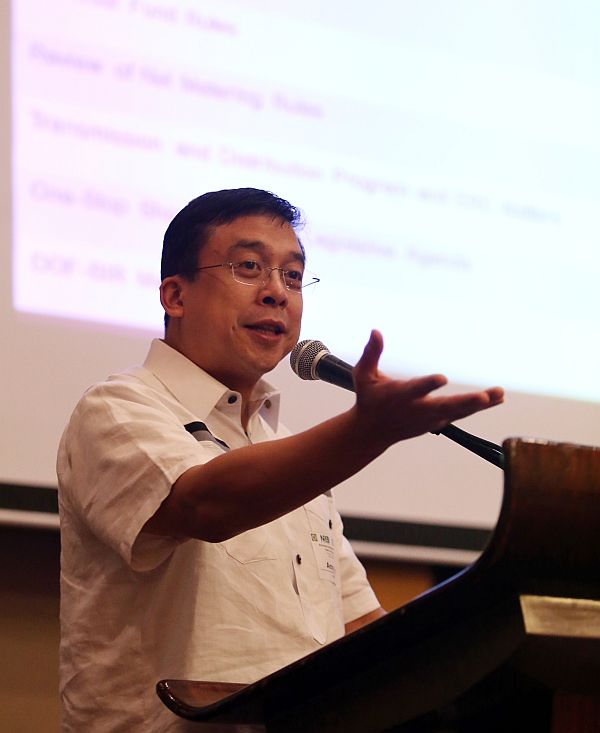Renewable energy initiative seen to lower power rates

Lawyer Jose Layug Jr., National Renewable Energy Board chairman, discusses the renewable energy market during Wednesday’s public consultation at the Marriott Hotel.
(CDN PHOTO/LITO TECSON)
Consumers, particularly those on off-grid islands, can expect lower power rates once an initiative to expand the use of renewable energy resources in the country goes full swing by 2018.
The National Renewable Energy Board (NREB) on Wednesday held a public consultation on Renewable Energy Market (REM) rules in Cebu City, wrapping up a series of forums this year aimed at fulfilling the mandate of the RE Act of 2008.
“It is clear in the mandate of the law to expand the use of renewable energy in the Philippines. There are many mechanisms provided in the law, among which is the Renewable Portfolio Standards (RPS),” said lawyer Jose Layug Jr., NREB chairman, in an interview on the sidelines of the forum at the Cebu City Marriott Hotel.
The RPS refers to a market-based policy that requires electric cooperatives and distribution utilities to get an agreed portion of their energy supply from eligible RE resources, thereby contributing to the growth of the RE industry.
Co-ops and utilities are required to ensure that one percent of their incremental demand must be sourced from RE.
REM
Meanwhile, the REM refers to the platform where trading of RE certificates equivalent to an amount of power generated from RE resources is made.
The RPS and REM rules are set to be reviewed by the Department of Energy (DOE) before the end of 2017.
Should the schedule go as planned, he said he hopes for the mechanisms to be implemented by January next year.
Once implemented, these will help the agency attain its goal of maintaining the RE share in the national energy mix to at least 35 percent by 2030.
RE plan
The National Renewable Energy Plan seeks to increase the RE-based capacity of the country to an estimated 15,304 Megawatts by the year 2030, almost three times its 2010 level.
Layug said that with these initiatives, more investors will be encouraged to build RE generation facilities across the country to meet the demand among utilities and cooperatives.
This is also projected to bring down the cost of power on off-grid islands, Bantayan Island in Cebu, for example, where more expensive diesel-fired generators are used to produce electricity for households.
Without this mandate, utilities and cooperatives will only keep sourcing their power from coal or diesel facilities.
“On the islands, if you mix that with RE, such as solar, wind, or biomass, prices will go down,” said Layug.
Lowering of UCME
He said this would ultimately lead to the lowering of the Universal Charge for Missionary Electrification (UCME), the amount on-grid consumers pay to subsidize the cost of power for consumers that are not connected to the grid.
Layug said RE plants that utilize geothermal energy and hydropower can now compete with traditional energy sources, stressing the need to increase the share of RE in the national energy mix even more.
As of 2015, around 32 percent of the Philippines’ power supply comes from RE sources, while only 20 percent of the global supply comes from RE.
VECO’S RE SOURCE
In Metro Cebu, however, the Visayan Electric Company (VECO) sources 50 percent of its power from RE sources.
In a previous report, VECO chief operating officer Anton Perdices said 89 percent of this comes from geothermal sources in Negros and Leyte.
“Renewable energy helps mitigate the effects of climate change, lessens dependence on imported fossil fuels, is cheaper than fossil-based technology in the long term, and the Philippines has a large resource base,” he had said.
While the utility recognizes the benefits of RE, it also acknowledged that initial investment required for RE facilities is still high at present.
RE also has reliability issues since it has varying capacity factors.
Perdices had said to provide reliable and competitively priced power, VECO has to maintain a balanced mix of generation sources.
Disclaimer: The comments uploaded on this site do not necessarily represent or reflect the views of management and owner of Cebudailynews. We reserve the right to exclude comments that we deem to be inconsistent with our editorial standards.
